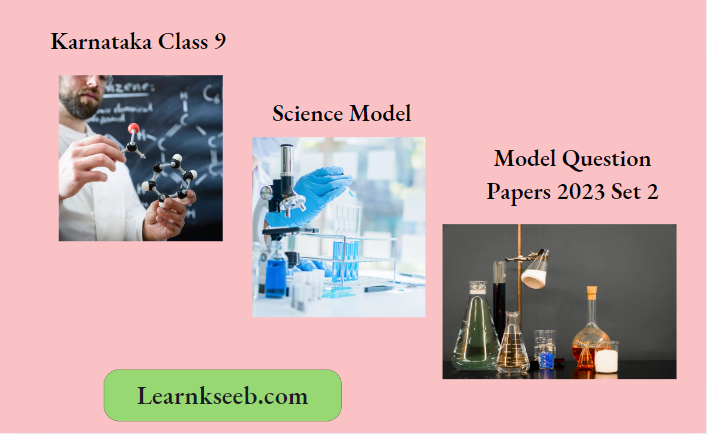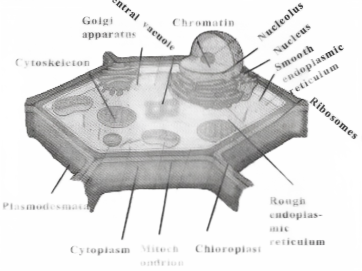Karnataka Class 9 Science Model Question Papers 2023 Set 2
Choose the correct alternative and Write the complete answer along with its alphabet in the sheet provided:
Question 1. In a uniform circular motion, the velocity of the particle is
- Constant
- Variable in magnitude
- Variable in direction
- (1) and (2)
Answer: 3. variable in direction
Question 2. If no external force acts on a body then the quantity that remains conserved is
- Momentum
- Work
- Energy
- Mass
Answer: 1. Momentum
Karnataka Class 9 Science Model Question Paper 2023
Question 3. The cork floats while the nail sinks in the water, this is due to
- The density of cork is more than nail
- The density of the nail is more than the cork
- The density of cork is less than the density of water
- The density of Iron is less than the density of water.
Answer: The density of cork is less than the density of water

Question 4. The one, in which interparticle forces are strongest is
- Sodium chloride
- Hydrogen
- Ether
- Carbon dioxide
Answer: 1. Sodium chloride
Class 9 Science Model Question Paper 2023 Karnataka Board
Question 5. An example of a liquid metal and of a liquid nonmetal is
- Gallium, mercury
- Mercury, chlorine
- Mercury, bromine
- Bromine, sulfur
Answer: 3. Mercury, bromine
Question 6.Explain
- sponge though compressible is a solid
- Rubber bands through stretchable are solid.
Answer:
- In minute pores of the sponge, the air is trapped, when pressed air is expelled out so it is compressible
- Rubber band changes shape under force and regains shape when force is removed.
Class 9 Karnataka Science Model Question Papers 2023 Set 2
Question 7. Name the following tissues:
- Found in the Iris of the eye
- That connects two bones
Answer:
- Unstriated muscles
- Ligament
Question 8. Give reasons for the following observations
- Naphthalene balls disappear with time without leaving any solid.
- Gas fills the vessel completely
Answer:
- Naphthalene being volatile converts from solid to gas directly by a process called sublimation. Therefore, no solid residue is left after some time as it takes the heat from surroundings and sublimes.
- Parencvmaarticles of gas have a negligible force of attraction between them and possess high kinetic energy.
Question 9. A sound wave travels at a speed of340ms‘. If its wavelength is 1.5cm, what is the frequency of the wave? will it be audible?
Answer:
Given,
speed of sound — 340ms-1
wavelength λ = 1.5cm = 0.015m
Frequency=speed / λ
= 340/0.015 = 22600Hz
Since the audible frequency range is 20 to 20,000 Hz. Thus, the sound frequency is 22,600 Hz. It is not audible.
Question 10. Write the difference between tendon and ligament
Answer:
Tendon:
- They join bone to muscles
- They have limited flexibility
- They have more strength
Ligament:
- They join bone to bone
- They have elasticity
- They have less strength
Question 11. A train travels at a speed of 60km/hr for 0.52hr, at 30 km/h for the next 0.24hr, and then at 70km/h for the next 0.71h. What is the average speed of the train?
Answer: In the first case the train travels at a speed of 60km/hforatimeof0.52h
Distance
Time
Distance ~ 60 x 0.52 = 31.2km In the second case the train travels at a speed of 30km/h for a time of 0.24h
Distance
Time = 30 x 0.24 = 7.2km
In the third case, the train travels at a speed of 70km/h for a time of 0.71 h
Distance
Time
= 70 x 0.71 = 49.7 km From equations 1,2 and 3 we get Total distance traveled = 31.2 + 7.2 + 49.7 = 88.1km
Total time taken = (0.52 + 0.24 + 0.71) = 1.47h
Question 12. Write two properties of colloid
Answer:
- They are heterogeneous solution
- particles that do not settle due to gravity.
Question 13. What is the endoplasmic reticulum? Name the two types of the endoplasmic reticulum.
Answer: Endoplasmic reticulum is a membranous network enclosing a fluid-filled lumen. The two types of endoplasmic reticulum are Rough endoplasmic reticulum and Smooth endoplasmic reticulum.
Question 14.Define:
- Fluid
- Buoyant force
Answer:
- Any substance which can flow is called a fluid.
- The upward force exerted by a liquid on an object which is immersed in the liquid is called upthrust or buoyant force.
Karnataka Board SSLC Class 9 Science Question Papers 2023
Question 15. What are the immunization programs available at health centers in and around your locality?
Answer:
- child immunization program
- polio eradication program
- H1N1 vaccination
Question 16. How do plants get nutrients?
Answer: Plants get nutrients from the air, water, and soil. There are sixteen nutrients essential for the growth of plants, and carbon and oxygen are supplied by water. The remaining thirteen nutrients are supplied by the soil.
Question 17.State the difference between macronutrients and micronutrients
Answer:
Macronutrients:
- There are required by crops in larger quantity
- Six macronutrients are nitrogen, phosphorus, potassium, calcium, magnesium, and sulfur
Micronutrients:
- These are required by crops in very small quantities.
- Seven micronutrients Iron, Manganese, boron, zinc, and copper. Molybdenum and chlorine.
Question 18. How do annelids differ from arthropod animals?
Answer:
Annelid:
- Exoskeleton present
- The body is segmented into the head, thorax, and abdomen
- sexes can be separate or can be on the same animal
Arthropod:
- No Exo skeleton
- The body is segmented into rings.
- Hermaphrodite
Class 9 Science Model Paper 2023 Karnataka Board PDF
Question 19. Name the phylum of the following animals
- Tapeworm
- Starfish
- Jellyfish
- Octopus
Answer:
- Tapeworm – Platyhelminthes
- Starfish – Echinodermata
- Jellyfish – coelenterate
- Octopus – Mollusca
Question 20. Explain how bats use ultrasound to catch prey.
Answer: Bats search out their prey by emitting and detecting reflections of ultrasonic waves. The high-pitched ultrasonic squeaks of the bat are reflected from the obstacles or prey and return to the bat’s ear. The nature of reflection tells the bat where the obstacle or prey is and what it is like.
Question 21. Soul says that the acceleration in an object could be zero even when several forces are acting on it. Do you agree with her? why?
Answer: yes, acceleration in an object could be zero even when several forces are acting on it. This happens when all the forces cancel out each other that is the net force acting on the object is zero.
Question 22. Why is a mixture called an impure substance?
Answer: A mixture consists of different components easily separated by physical processes, hence it is called an impure substance.
Question 24. What are the limitations of J.J. Thomson’s model of the atom?
Answer:
- It could not explain the result of the scattering experiment performed by rutherford
- It did not have any experimental support
Answer The Following:
Question 1. To make a saturated solution 36g of sodium chloride is dissolved in 100g of water at 293K. Find its concentration at this temperature.
Answer:
mass of solute = 36g
mass of solvent = 100g
mass of solution = 136g
mass percentage of solution
Question 2. List the difference between plant cells and animal cells.
Answer:
Plant cell:
- It has a cell wall
- They contain chloroplast
- They do not have centriole
- A vacuole is large and present in the center of the cell.
- The nucleus is present in the side of the plant cell
Animal cell:
- It doesn’t have a cell wall.
- They don’t have chloroplast
- The centriole is present in them.
- Vacuole is small
- The nucleus is present in the center of the animal cell.
Karnataka State Board Class 9 Science Sample Paper 2023
Question 3. Two children are at opposite ends of an aluminum rod. one strikes the end of the rod with a stone. Find the ratio of times taken by the sound wave in the air and in aluminum to reach the second child.
Answer: Speed of sound in air, v= 346 m/sec
speed of sound in aluminium v2= 6420 m/sec
let the length of the aluminum rod =x m
Karnataka Class 9 Science Sample Papers Set 2 2023
Question 4. How are sol, solution, and suspension different from each other?
Answer:
Sol:
- size of solute particles between into 10nm
- It is stable
- It scatters a beam of light
- Solute particles pass through filter paper
Solution:
- Size of solute particles less than 1nm
- Stable
- It does not scatter light.
- Solute particles pass through filter paper
Suspension:
- The size of solute particles is more than 100nm
- unstable
- It scatters a beam of light
- Solute particles do not pass through filter paper.
Answer the following :
Question 1. Which method is used for the separation of a mixture of alcohol and water? Draw a neat labeled diagram of the apparatus used in the above separation technique.
Answer:

Question 2. Draw a neat labeled diagram of the plant cell.
Answer:

Karnataka Board Class 9 Science Previous Year Papers
Question 3. State the difference between simple tissues of plants.
Answer:
Parenchyma:
- The cells are living and thin-walled
- The cells are oval, spherical, or polygonal in shape
- There is a large, intercellular space between
Collenchyma:
- The cells are living and thick at comers
- The cells are elongated at comers
- There is very little intercellular space
Sclerenchyma:
- The cells are dead and thick-walled due to lignin deposition
- The cells are long and narrow.
- There is no intercellular space
Karnataka 9th Standard Science Model Paper 2023
Question 4. An object is thrown vertically upwards and rises to a height of 10m. Calculate
(1) the velocity with which the object was thrown upwards and
(2) the time is taken by the object to reach the highest point.
Answer: s = 10m, v =0ms-1, g = 9.8ms-2, a = 9.8ms-2
(1) \(v^2=u^2+2 a s\)
\(0=u^2+2 \times(-9.8) \times 10\) \(\begin{aligned}& -u^2=-2 \times 9.8 \times 10 \\
& u=\sqrt{196}
\end{aligned}\)
U=g 14m s1
(2) v = u + at
0= 14 – 9.8 x t
t= 1.43s
